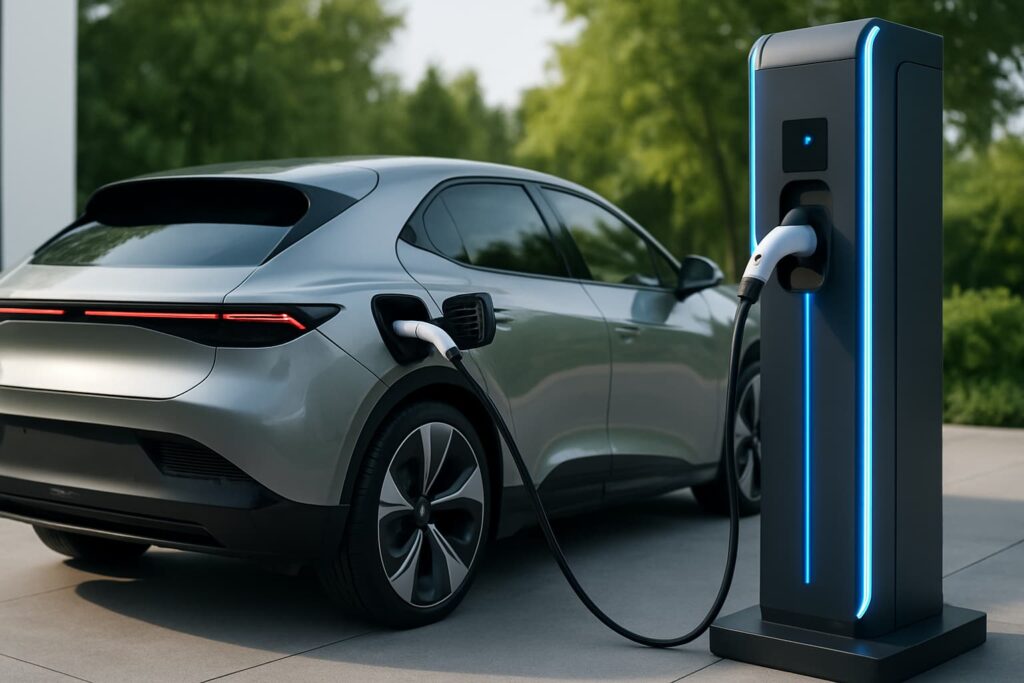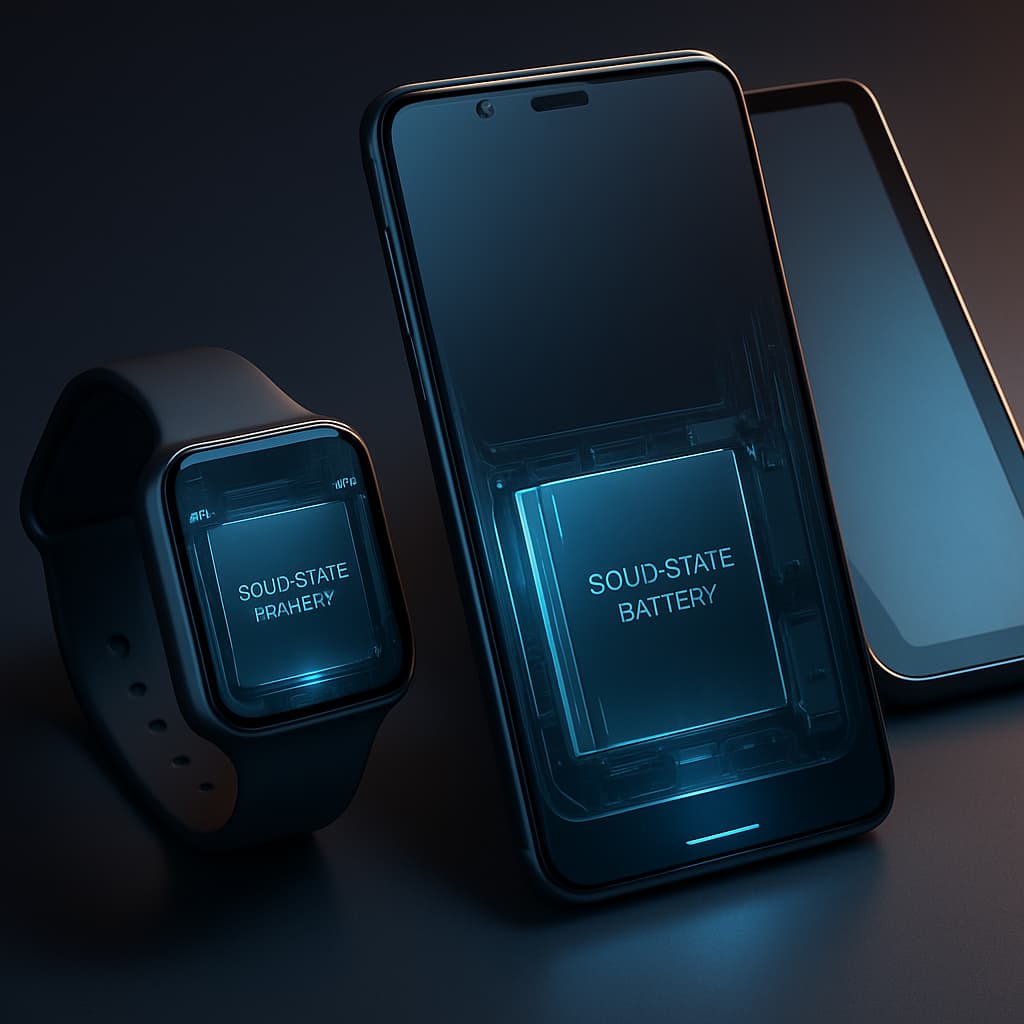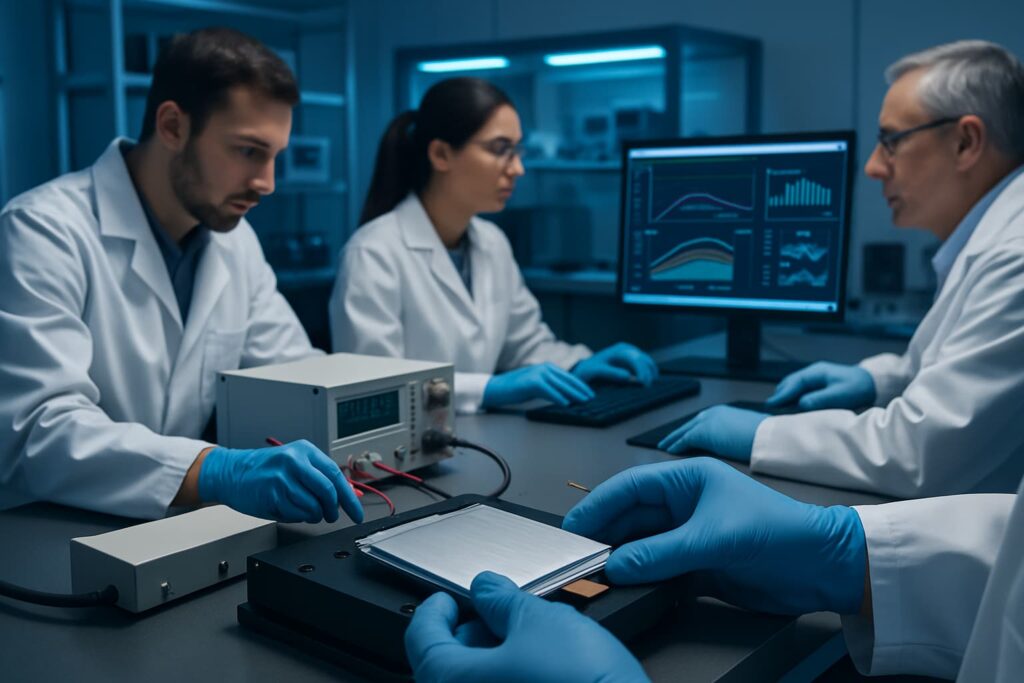Have you ever wondered why your phone battery dies so quickly or why electric cars can’t go further on a single charge? The answer might lie in solid-state batteries, an exciting technology that’s changing how we store power.
As someone who has researched battery technology for years, I’m excited to share how these new batteries work and why they matter to you. Whether you drive an electric car or want your phone to last longer, solid-state batteries will change how you use technology daily.
What Are Solid-State Batteries?
Solid-state batteries are rechargeable power sources that use a solid material inside instead of the liquid or gel in regular batteries. This solid material, called an electrolyte, moves energy more efficiently and safely.
Think of it like carrying water. Traditional batteries are like carrying water in a plastic bag—they work, but they can leak or break easily. Solid-state batteries are more like carrying water in a sturdy bottle—they are more reliable and less likely to cause problems.

Manufacturers make these solid electrolytes from materials like ceramics, sulfides, or phosphates. These materials create a stronger, more dependable way to store and move energy compared to the liquid electrolytes in the batteries you use today.
How Do Solid-State Batteries Work?
When you charge or use a battery, tiny particles called ions move back and forth between two parts of the battery – the cathode and the anode. In traditional batteries, these ions swim through a liquid or gel. Solid-state batteries travel through a solid material instead.
You can picture it like people moving through a building. In old batteries, it’s like people swimming through a crowded pool to get where they need to go. In solid-state batteries, it’s more like walking on a clear path – faster and more direct.
This solid pathway helps ions move more efficiently, so your devices can store more energy and access it more quickly. The result? Longer-lasting power and faster charging for everything from your phone to your car.
Applications Of Solid-State Batteries
Scientists are developing solid-state batteries for many purposes. They are especially interested in using them in electric vehicles (EVs), as researchers believe they can improve their performance.

Electric Vehicles (EVs)
When solid-state batteries come to electric cars, you’ll notice big changes. Your EV could go twice as far on a single charge and fill up much faster at charging stations.
Car companies like Toyota and BMW are working hard to put solid-state batteries in their vehicles. When they succeed, you’ll spend less time charging and more time driving. Plus, these batteries are safer, reducing the rare but scary risk of battery fires.
“We expect to see the first commercial electric vehicles with solid-state batteries on the road by 2027,” says a Toyota researcher. “This will be a game-changer for everyday drivers.”
Consumer Electronics
Imagine your phone lasting for days instead of hours, or your laptop working through an entire international flight without needing a charge. With solid-state batteries, this will become reality.

You’ll also notice your devices charging much faster, perhaps fully charging in minutes rather than hours. And since these batteries last longer before wearing out, you won’t need to replace your devices as often, saving you money and reducing waste.
Energy Storage Systems
Beyond cars and phones, solid-state batteries will transform how we store energy from solar panels and wind turbines. This matters because renewable energy only works when the sun shines or the wind blows – unless we can store that energy effectively.
With better storage, you could power your home with solar energy at night or during stormy weather. This makes renewable energy more practical for everyday use and helps us move away from fossil fuels.
Benefits of Solid-State Batteries
1. Higher Energy Density
Solid-state batteries are used in electric vehicles because they are more efficient than lithium-ion batteries. Their most important advantage is “space efficiency”—solid-state batteries provide higher energy density because they do not use liquids. They are smaller but have a large internal capacity. Additionally, they do not use liquid sodium, which significantly contributes to their size. As a result, solid-state batteries have the potential to extend the driving range and lifespan of EVs.
2. Higher safety
Have you seen those scary videos of phones or laptops catching fire? That happens because the liquid inside traditional batteries can overheat and burn.
Solid-state batteries don’t have this problem. The solid materials don’t burn easily, making these batteries much safer for everyday use. You won’t have to worry about your phone overheating in your pocket or your electric car battery catching fire after an accident.
3. Longer Lifespan
Regular batteries wear out after about 500-1,000 charge cycles. Solid-state batteries could last for 2,000-3,000 cycles or more.
What does this mean for you? If you charge your phone once a day, a solid-state battery could last 5-8 years before showing significant wear, compared to 1-3 years for current batteries. This means fewer frequent replacements and less electronic waste.
Read more about Solid-State vs. Lithium-Ion Batteries
4. Faster Charging Times
Solid-state batteries charge much faster than regular lithium-ion batteries. The solid material inside these batteries allows ions to move faster, so charging occurs more quickly. Fast charging is beneficial for electric vehicles, making driving EVs more convenient.
5. Lightweight And Compact
Solid-state batteries are smaller and lighter than traditional batteries with the same power. This weight saving is especially important for electric vehicles, where battery weight affects how far and how efficiently the car can travel.
For your portable devices, this means slimmer, lighter designs that are easier to carry and use. Manufacturers can either make devices smaller or use the extra space for other features you’ll enjoy.
What Are The Disadvantages of Solid-State Batteries?
Solid-state batteries could significantly change the energy storage industry. They hold more energy in a smaller space than lithium-ion batteries and offer improved safety. However, some challenges could prevent the widespread use of these new batteries.
1. High Manufacturing Costs
Solid-state batteries are expensive to make. The process of building them with solid materials is complex and pricey. Because of these high costs, people won’t immediately find solid-state batteries in many everyday electronics or electric cars. Companies also struggle to make enough batteries efficiently because they have problems with their supply chains.
2. Limited Power Output
Solid-state batteries store a lot of energy, but they release power slowly. This limitation affects how quickly energy is released from the battery, limiting its use in devices and vehicles that require a lot of power. For instance, electric cars might not quickly adopt solid-state batteries. Electric cars might have slower acceleration compared to vehicles using standard lithium-ion batteries.
3. Temperature Sensitivity
Supposedly, Solid-state batteries need a specific temperature to work correctly. If the temperature changes too much, it can harm the battery. Also, arid heat or cold can make the battery stop working entirely. Extremely hot or cold weather will stop the battery from working correctly.
4. Longevity Issues
The lifespan of modern solid-state batteries is an important quality. However, new solid-state batteries face significant lifespan issues. These problems result from the connections between the solid electrolyte and the electrodes. Over time, these connections deteriorate, causing the battery to lose efficiency and perform poorly.
5. Scalability Challenges
People believe solid-state batteries are easy to make in large numbers. That belief is incorrect. Current methods for building solid-state batteries are complex, making it challenging to produce them. The difficulty creates a major obstacle to their widespread use. Unlike traditional batteries, new battery technology faces more significant challenges regarding adoption.
6. Brittle Material Composition
The materials used in solid-state batteries are often brittle. Batteries are prone to exploitation and tend to crack or break under extreme mechanical stress due to expansion and contraction. A weak structure and additional stiff material increase the risk of the battery breaking.
7. Slow Charging Times
Solid-state batteries usually take longer to charge fully than lithium-ion batteries. As a result, there is still much work to be done in electric vehicles, where charging speed is a top priority. The low rate at which solid-state batteries charge can make using devices that rely on them cumbersome.
8. Limited Supplier Base
The solid-state industry faces a challenge because only a few companies manufacture the necessary high-quality materials. The limited number of providers creates problems for the supply network, which can lead to production delays. Consequently, companies struggle to meet customers’ demands. The industry needs more suppliers to ensure a smooth flow of materials.
9. Complexity in Integration
The Teslas and iPhones of the world already have a lot of working hardware and software that use traditional charging methods. For solid-state batteries to work, significant alterations to both the hardware and software would be needed, which would greatly increase the cost and complexity of development and deployment.
10. Regulatory and Safety Testing
The difference between solid-state batteries and other technologies is the additional testing that needs to be done before they can be implemented. Making sure they are safe and effective is crucial, but the process requires a lot of time and money.
The Future of Solid-State Batteries

Despite these challenges, the future looks bright for solid-state batteries. Experts predict we’ll see them in high-end electronics within 2-3 years and in electric vehicles within 5-7 years.
Companies like QuantumScape, Solid Power, and Toyota are investing billions in solving the remaining problems. When they succeed, we’ll see a revolution in how we power our lives.
“Solid-state battery technology isn’t just an improvement – it’s a complete game-changer for energy storage,” says Dr. Sarah Chen, battery researcher at MIT. “Once we overcome the current challenges, the benefits for consumers will be enormous.”
Practical Advice: What This Means For You
When to Expect Solid-State Batteries
You’ll likely see the first consumer devices with solid-state batteries around 2027-2028, with electric vehicles following shortly after. High-end products will get them first, before the technology becomes more affordable and widespread.
How to Prepare
If you’re buying a new phone or laptop in the next 2-3 years, you’ll probably still get one with a traditional battery. But if you’re planning to buy an electric vehicle, you might want to consider leasing rather than buying, so you can upgrade more easily when solid-state models become available.
Environmental Benefits
By lasting longer and containing fewer toxic materials, solid-state batteries will help reduce electronic waste. When you do eventually buy devices with these batteries, you’ll be making a more environmentally friendly choice.
Conclusion
Solid-state batteries are changing energy storage. They use solid materials, making them more powerful, safe, and fast-charging. They suit electric cars and electronics. While costly and challenging to produce, they may be shared by 2030, which could lead to a cleaner energy future.
FAQs
What are solid-state batteries, and how do they differ from lithium-ion batteries?
Solid-state batteries use a solid electrolyte (made of ceramic, sulfide, or phosphate) instead of the liquid or gel electrolyte in lithium-ion batteries. This solid structure improves energy density, safety, and charging speed while reducing degradation over time.
What are the key advantages of solid-state batteries?
1. Higher energy density (more power in smaller sizes).
2. Improved safety (no flammable liquid electrolytes).
3. Longer lifespan (slower degradation of internal components).
4. Faster charging times (due to efficient ion movement).
5. Compact and lightweight design.
Are solid-state batteries safer than lithium-ion batteries?
Yes. Unlike lithium-ion batteries, which use flammable liquid electrolytes, solid-state batteries use non-flammable solid electrolytes, significantly reducing the risk of fires or explosions from damage or overheating.
Which industries or companies are investing in solid-state battery technology?
Major automakers (e.g., Toyota, BMW) and electronics manufacturers are leading development efforts. The technology is also relevant to renewable energy storage and power grid applications.
Are solid-state batteries more environmentally friendly?
Yes, solid-state batteries are generally more environmentally friendly than traditional lithium-ion batteries for several reasons. They last 2-3 times longer, which means fewer replacements and less waste. They also don’t contain the flammable liquid electrolytes found in conventional batteries, making them safer to dispose of. Some solid-state battery designs use fewer rare earth materials, reducing the environmental impact of mining.
Will solid-state batteries make electric vehicles cheaper?
Due to new technology and limited production, electric vehicles with solid-state batteries will likely cost more initially. However, we expect prices to drop significantly over the long term (5-10 years after introduction). The longer lifespan of these batteries will reduce the total cost of ownership, even if the upfront price remains higher. Additionally, as production scales up, manufacturing costs will decrease.
Can solid-state batteries explode like lithium-ion batteries?
No, solid-state batteries are much less likely to catch fire or explode compared to lithium-ion batteries. This is one of their biggest safety advantages. Traditional lithium-ion batteries use flammable liquid electrolytes that can leak and ignite under certain conditions. Solid-state batteries replace this with non-flammable solid materials, virtually eliminating the risk of fire or explosion even if the battery is damaged.
Can existing devices be retrofitted with solid-state batteries?
In most cases, retrofitting existing devices with solid-state batteries won’t be practical or cost-effective. Manufacturers design devices around specific battery shapes, sizes, and electrical characteristics. However, some companies are working on “drop-in replacement” solid-state batteries that match the dimensions and specifications of standard battery sizes. These might allow for upgrades in some devices, but don’t expect this to be widely available.
Read more about How To Make A Solid State Battery From Scratch.







